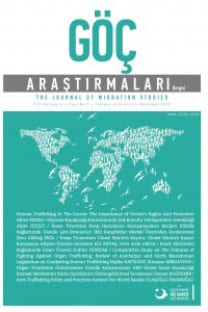Çağdaş Japonya’da Yeni Göçmenlik Politikasına Öncülük Etme
Dış bağlamdan bakıldığında Japonya’nın tek parçalı kültürel bir toplum gibi görünmesine rağmen, derinlemesine incelendiğinde yaygın bir şekilde algılanan tamamen homojen bir toplum ve devletten bambaşka bir görüntü sergileyen farklı gruplar ve topluluklar çeşitliliği ortaya çıkmaktadır. Bu farklı Japonya görüntüsü özellikle uluslararası öğrenciler ve mülteciler dalgasını artırarak çağdaş göçmenler için yeni konaklama yolları geliştirilmesiyle genişletilecektir. Aslında bu süreç 2014 yılından bu yana hükümet tarafından Japonya Yeniden Canlandırma Projesi (JRP) kapsamında politika değişiklikleri aracılığıyla kuvvetli bir şekilde desteklenmektedir. Bu makale uluslararası öğrenciler, göçmenler ve mültecilere odaklanan göçmen politikalarının mevcut etkilerini ele alır ve analiz eder. Japon yetkililer tarafından oluşturulan strateji çalışmak ya da okumak isteyen “yeni gelenlere” büyük avantajlar sağlamaktadır. Ancak aynı zamanda Japonya sınırlarında sığınma talep eden insanlar bürokrasi bariyerleri nedeniyle birçok engelle karşılaşmaktadır.
Anahtar Kelimeler:
Japonya, Öğrenciler, Göçmenlik, Politika
Pioneering New Immigration Policy in the Contemporary Japan
Although Japan from an outside context may exhibit a monolithic cultural society, once immersed it exposes a variety of diverse groups and communities displaying a far disparate vision from entirely homogenous society and state that is commonly perceived. This vision of diverse Japan will be extended by developing new ways of accommodation for the contemporary immigrants, especially increasing wave of international students and refugees. In fact, this process had been strongly pushed by the government since 2014, through policy changes within Japan Revitalization Project (JRP). This paper will discuss and analyses current effects of those migration policies focusing on international students, migrants and refugees. The strategy made by the Japanese authorities is giving major advantages to “newcomers” wanting to work or study. However, at the same time, people seeking refuge within borders of Japan still are facing many obstacles due to bureaucracy barriers.
Keywords:
Japan, Students, Immigration, Policy,
___
- Carrigan, L. (2017, February 21). Japan’s New Permanent Residency Rules Explained. Retrieved from https://blog.gaijinpot.com/japans-new-permanent-residency-rules-explained/
- Castles, S., Haas, H. D., & Miller, M. J. (2013). The Age of Migration (5th Edition ed.). Palgrave.
- Chikako Kashiwazaki, T. A. (2006). Japanese Immigration Policy: Responding to Conflicting Pressures. Migration Policy Institute. Retrieved from http://www.migrationpolicy.org/article/japanese-immigration-policy-responding-conflicting-pressures
- Freeman Spogli Institute for International Studies. (2010). Koreans in Japan. Retrieved from https://spice.fsi.stanford.edu/sites/default/files/Koreans_inJapan.pdf
- Hawksworth, J., & Chan, D. (2015 ). The World in 2050: Will the shift in global economic power continue? Pricewaterhouse LLP. Retrieved from http://www.pwc.com/gx/en/issues/the-economy/assets/world-in-2050-february-2015.pdf
- Higuchi, N. (2005, December 2). BRAZILIAN MIGRATION TO JAPAN: TRENDS, MODALITIES AND IMPACT. Retrieved from http://www.un.org/esa/population/meetings/IttMigLAC/P11_Higuchi.pdf
- Hollingworth, W. (2017, January 2). Study explores deafening silence in Japan’s English-language classes. Retrieved from http://www.japantimes.co.jp/news/2017/01/02/national/study-explores-deafening-silence-japans-english-language-classes/#.WLQl_fmLTD4
- Japan, The Immigration Bureau of. "Start of a new residency management system." 2012. http://www.immi-moj.go.jp/newimmiact_1/pdf/NewResidencyManagementSystem-(EN).pdf
- Japanese International Training Cooperation Organization. Outline of Technical Intern Training Program. 2016. http://www.jitco.or.jp/english/overview/itp/index.html
- JASSO."International Students in Japan." 2015. https://www.jasso.go.jp/en/about/statistics/intl _student/__icsFiles/afieldfile/2016/04/20/data15_brief_e.pdf
- Jones, C. Japan’s Constitution won’t protect revolting foreigners. October 11, 2015. http://www.japantimes.co.jp/community/2015/10/11/issues/japans-constitution-wont-protect-revolting-foreigners/#.WJXfmGhxqUk
- Miyazaki, A., & Funakoshi, M. (2017, February 9). Japan took in just 28 refugees in 2016, despite record applications. http://www.reuters.com/article/us-japan-asylum-idUSKBN15O0UV
- Murai, S. (2016, January 23). Japan recognizes only 27 refugees, despite rising numbers of applications. The Japan Times. http://www.japantimes.co.jp/news/2016/01/23/national/social-issues/japan-recognizes-27-refugees-despite-rising-numbers-applications/#.WIiHiWVxqUk
- Osaki, Tomohiro. Japan's foreign residents offer up insights in unprecedented survey on discrimination. March 31, 2017. https://www.japantimes.co.jp/news/2017/03/31/national/japans-foreign-residents-sound-off-in-unprecedented-survey-on-discrimination/#.XH0zhrkUmM8
- Peng, Ito. Japan and its immigration policies are growing old. East Asia Forum. June 7, 2016. http://www.eastasiaforum.org/2016/06/07/japan-and-its-immigration-policies-are-growing-old/
- Philippines Overseas Employment Administration. "Japan needs nurses, caregivers." Philippines Overseas Employment Administration. June 21, 2016. http://www.poea.gov.ph/news/2016/06-2.pdf
- Potter, David M. Evolution of Japan’s Postwar Foreign Policy . 2009. https://office.nanzan-u.ac.jp/cie/gaiyo/kiyo/pdf_09/kenkyu_03.pdf
- Prime Minister of Japan and His Cabinet. "Japan Revitalization Strategy - Japan's challenge for the Future" June 24, 2014. http://www.kantei.go.jp/jp/singi/keizaisaisei/pdf/honbunEN.pdf
- Reynolds, I., & Roman, D. (2016, September 23). Japan grows more open to foreign workers as population declines. The Japan Times. http://www.japantimes.co.jp/news/2016/09/23/national/politics-diplomacy/japan-grows-open-foreign-workers-population-declines/#.WIhqO2VxqUk
- Rodionova, Z. (2017, March 21). Japan loosens permanent residency rules to keep highly skilled foreign workers and lure global talent. http://www.independent.co.uk/news/business/news/japan-permanent-residency-rules-skilled-foreign-workers-lure-global-talent-ministry-justice-a7616426.html
- Shanghai Ranking Consultancy. (2016). Academic Ranking of World Universities 2016 - Japan. Shanghai. Retrieved from http://www.shanghairanking.com/World-University-Rankings-2016/Japan.html
- Statistic Bureau of Minister of Internal Affairs and Communications. (2016). Japan Statistical Yearbook 2017. Statistic Bureau. Retrieved from http://www.stat.go.jp/data/nenkan/66nenkan/zuhyou/y662529000.xls
- The immigration Bureau of Japan. Points-based System for Highly Skilled Foreign Professionals. 2017. http://www.immi-moj.go.jp/newimmiact_3/en/system/index.html
- The Immigration Control and Refugee Recognition Law. (2014). Foreign nationals who are permitted to work in Japan and those who are not. 2014. http://tokyo-foreigner.jsite.mhlw.go.jp/english/seekers_1/spec/spec_1a.html
- The Japan Foundation. Japanese-Language Pre-training Program for Indonesian and Filipino Candidates for Nurses and Care Workers under Economic Partnership Agreements (EPA). 2015. https://www.jpf.go.jp/e/project/japanese/education/training/epa/
- The Japan Times. 70% of foreign students shun offers from University of Tokyo degree programs in English. March 29, 2015. http://www.japantimes.co.jp/news/2015/03/29/national/70-of-foreign-students-shun-offers-from-university-of-tokyo-degree-programs-in-english/#.WKamKWhxqUl
- The Ministry of Education. "Overseas Study by Japanese National." 2015
- The Ministry of Education. The Number of Japanese National Studying Overseas and the Annual Survey of International Students in Japan. February 27, 2015. http://www.mext.go.jp/en/news/topics/detail/1372624.htm
- The Ministry of Education. "Top Global University Project." September 2014. https://www.mext.go.jp/b_menu/houdou/26/09/_icsFiles/afield-file/2014/10/07/1352218_02.pdf
- The Ministry of Internal Affairs and Communication. (2016). Japan Statistical Yearbook 2017. http://www.stat.go.jp/english/data/nenkan/66nenkan/index.htm
- The Ministry of Justice. "Immigration Control." Part I. Immigration Control in Recent Years. Tokyo, 2015.
- The Ministry of Justice. "Japanese Immigration Control and Refugee Recognition Act." 2006. http://www.refworld.org/pdfid/3ae6b5754.pdf
- The UN Refugee Agency. (2016, September 30 ). Donors. http://www.unhcr.org/donors.html
- The United Nations. Immigration Control and Refugee Recognition Act. 1951. http://www.immi-moj.go.jp/english/newimmiact/pdf/RefugeeRecognitionAct01.pdf
- ISSN: 2149-5548
- Başlangıç: 2015
- Yayıncı: Göç İdaresi Genel Müdürlüğü
Sayıdaki Diğer Makaleler
Göç ve Entegrasyon Politikalarında Vatandaşlık
Çağdaş Japonya’da Yeni Göçmenlik Politikasına Öncülük Etme
Fransız Kamusal Alanında Bütünleşme Stratejisi
Avusturya’daki Türk Göçmenlerin Entegrasyon Algıları
Entegrasyonun Politika Amaçlarına Ulaşmada Avusturalya'daki Mülteci Krizinin Ele Alınması
Sherene OZYUREK, Maurice GERKENS
Uluslararası Standartlara Uyum: Birleşik Krallık ve Çocukların İdari Gözetimi
Türkiye'deki Suriyeli Mültecilerin İşgücü Piyasası Entegrasyonu: Mültecilikten Göçmenliğe
